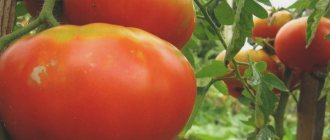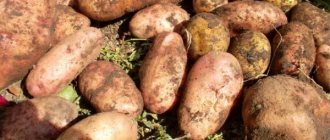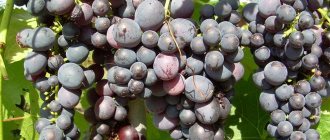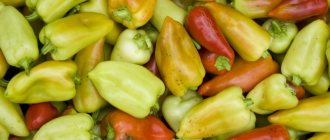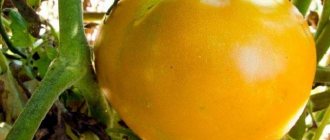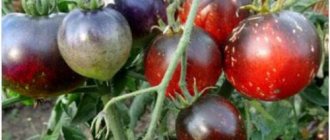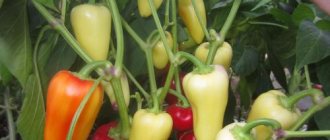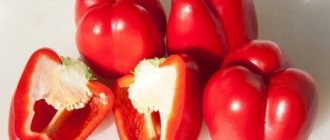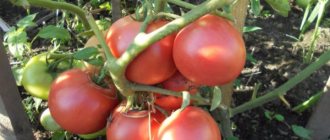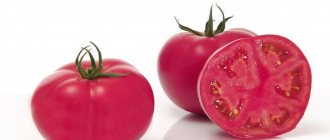It’s rare that a gardener, seeing colorful bags of seeds of various peppers in the store, holds back so as not to once again buy some variety or hybrid.
Today the choice is very large, but you need to know what characteristics of peppers to pay attention to so that your work is not wasted and an excellent harvest is obtained.
Among the favorites of many are low-growing peppers, which may not be as productive as their tall counterparts, but are more unpretentious in care. Our story will be about them.
Description and characteristics of the variety
Pepper Ilya Muromets is a mid-season variety. Among his values are productivity and large fruit. The first harvests are harvested 120 days after germination of seedlings.
The plants are characterized by standard growth; they have a closed crown (no formation is required). The bushes are compact, low - the length of the stems is within 50-60 cm.
What are the characteristics of the fruit:
- average weight 180-300 g;
- ruby staining;
- pericarp 5-6 mm;
- the skin is smooth and glossy;
- elongated cone shape;
- no transverse ribbing;
- length 12-14 cm.
The taste is dominated by sweetness; such fruits are great for salads and slices. They are also stuffed, stewed, baked, and pickled.
Sweet pepper Ilya Muromets can be cultivated in greenhouses, greenhouses, in open areas - in the field and garden.
Properties
For the most part, determinate peppers are early-ripening varieties and hybrids (and some even ultra-early-ripening), having fruits of various shapes, sizes and weights. This category includes peppers, the first fruits of which can be harvested after 90-105 days (for example, Red Square), as well as mid-season varieties and hybrids.
The shapes and sizes of sweet pepper fruits are very different, and in the group of determinate plants you can find “cubes”, prisms, cones, “bochata”, ideally even or ribbed fruits.
ON A NOTE! A description of the shape, weight and color of the fruit must be indicated in the description of the pepper.
In a state of technical maturity, all peppers have a green color (the saturation can be different), but already in the period of full ripening (biological maturity) you can see the full range of colors: red, scarlet, orange, yellow, cream and even dark purple.
Low-growing peppers have varieties with thick-skinned fruits, which are excellent for making lecho and stuffing. Varieties with thin pericarp have been developed, usually used fresh and for preservation. Productivity also varies, but we must not forget that this indicator largely depends on proper care.
Due to the early ripening period and the small height of the bush, the fruits on such peppers form quickly. On average, from most varieties the first fruits can be harvested after 100-110 days (in the technical ripeness phase), spending a minimum of effort on care and fertilizing. This option will not work with tall peppers, since they need to gain growth first, and the production of the first fruits occurs later.
Of course, in terms of taste, the fruits of varieties and hybrids of determinate peppers may be inferior to indets. But, firstly, today many excellent varieties of peppers, productive hybrids, distinguished by excellent taste, have been bred. Secondly, it is recommended to plant different varieties of peppers (low-growing, indets) on the site (in the beds, in the greenhouse) in order to obtain a harvest throughout the season.
Advantages of compact peppers
Manufacturers of seed material carefully inform buyers about the characteristics of the variety; you need to read everything that is written on the bag carefully.
Beginners and experienced gardeners choose a variety based on the following parameters:
- Plant size and fruit type.
- Growing conditions (open or closed ground).
- Temperature regime.
- Terms of ripening.
- Productivity per square meter.
Tall representatives of sweet peppers require more attention; they are planted, tied up, shaped, and fed in greenhouse conditions. These varieties are the most productive (up to 12 kg/m²), but they are troublesome and somewhat more difficult to care for.
If the plot is small and the greenhouse has not yet been built, there is only the possibility of temporary shelter of the plantings and there is no experience, then your choice should be focused on low-growing varieties and hybrids of sweet peppers.
Compact plants allow you to increase the density of plantings and ultimately get the same amount of juicy fruits as in a greenhouse on tall bushes.
Low bushes of sweet, low-growing varieties have a strong stem, stepsons and side branches grow slowly. A branched, strong root system allows plants to easily survive drought and hot temperatures.
Varieties and hybrids of low-growing sweet peppers
Let's look at the most popular varieties of determinants, which gardeners in different regions respond positively to.
Chanterelle
Domestic variety.
Fruits can be collected 100 days after planting. The pods are light green or orange, slightly elongated, small in size, with an even skin.
One of several varieties that can bear fruit on a loggia, since it does not require a large area and can grow in pots.
The variety can be grown both in the garden and in greenhouses. The seedlings are transferred to a permanent location in March. There should be 5-6 plants on one square. The side shoots of the pepper must be pruned. One bush gives 1.5-2 kg. fruits in season.
Boneta
An early variety with a growing season of 90 days. Productivity: 3-3.5 kg. from square.
Technically ripe fruits of this variety are cream-colored, while fully ripe fruits are red-orange.
The low bushes are 50 cm long and have little foliage. The variety is resistant to temperature fluctuations and lack of light.
The fruits are prism-shaped, voluminous, weighing from 300 to 400 grams. The wall thickness is 7 mm. Peppers can be stuffed, added to lecho, first and second courses. Suitable for fresh consumption.
It is better to grow in a greenhouse or in beds under film.
Timoshka
A very compact pepper, well adapted to cramped conditions when seedlings are densely spaced in the beds.
This is a mid-season variety with a development period of 110 days.
The weight of the fruit is approximately 300 g, but the pepper cannot boast of yield. During the season, only 3-4 ovaries appear on one plant.
Timoshka is valued for its excellent taste and dense walls with a thickness of up to 1 mm. Approximately 1 kg is removed from the bush. fruits and used to make salads.
Gemini
An early hybrid bred in Holland. It is impossible to grow it from your own seeds; planting material must be purchased.
The bush reaches a maximum of 40 cm. There are few dark green wrinkled leaves. Created specifically for growing in small film greenhouses. Fully matures in 2.5 months.
Peppers of this variety have a long stalk, so you can harvest without fear of injuring the bush. The color of technically ripe fruits is dark green, and fully ripe ones are bright yellow. Smooth pods with glossy skin weigh 200-300 g.
You may be interested in: Favorable days for planting pepper for seedlings in 2021: terms and rules for sowing at home Favorable days for picking pepper in 2021 according to the lunar calendar Favorable days for sowing sweet and bitter pepper for seedlings in 2021
Gemini has excellent taste and high resistance to temperature fluctuations.
There should be 3-4 plants on one square, since the hybrid requires adequate nutrition. In difficult regions, pepper develops correctly only in protected soil.
The variety is stuffed and added to salads and other dishes.
Ilya Muromets
Peppers of this variety are very strong, one might say, heroes. That's why the vegetable was named that way. The growing season of mid-season pepper is 125 days.
The bushes are small, standard. The shape of the fruit is prism-shaped, the weight of each pepper is 180-200 grams. In greenhouses, with proper care, fruits up to 300 g are formed. The skin of the peppers is glossy, the wall thickness is 5 mm. The pulp has a rich taste and a barely noticeable aroma.
The variety is not capricious, with an average yield, which increases if all recommendations are followed. As a rule, up to 5 kg are collected from one square. peppers
The culture is resistant to a number of diseases, one of which is verticillium.
Can be grown in a greenhouse, in open space and under film.
Eroshka
The variety is distinguished by voluminous cube-shaped fruits of red-orange color. The bushes of the plant are small, about 40 cm, with few leaves.
Standard compact bushes do not require garter, but they need to be shaped.
The yield, if all agricultural techniques are followed, is up to 16 kg. from the bush. The period of technical ripening of fruits is 95 days, biological - 135.
Eroshka bears fruit well in a cramped area, when 1 square can accommodate 10-12 specimens. Often the variety grows in a greenhouse next to other peppers or tomatoes, but in this case you need to carefully monitor the plant’s nutrition.
Fruit weight is 150-180 grams. Delicious peppers of this variety are an excellent ingredient in salads.
Sveta
Classic bell pepper with cone-shaped fruits. Peppers are covered with thick, glossy skin. Their weight is 80 g. Fully ripened fruits are bright yellow.
Light is a determinant. The height of the bush is approximately 60 cm. There is little foliage on small bushes.
The variety produces a high-quality harvest in the garden under film. Adapted to areas with short summers. The bushes bear fruit together.
The main advantage of this pepper is its immunity to disease.
Fakir
An early ripening variety with small fruits and a growing season of 90-95 days. Juicy peppers weigh a little - 65 g.
The height of the bush is approximately 50 cm, the foliage is moderate. At the beginning of ripening, the pods are yellow-green, at the end - rich red. Wall thickness 4 mm. The variety is valued for its rapid fruit formation and excellent taste.
To date, variants of the Fakir variety have been created with yellow and brown peppers. They are canned and added to salads, vegetable cuts and main courses.
Agapovsky
This variety was developed many years ago, but is still a leader in demand. The fact is that it is not capricious, it is distinguished by high fertility and fragrant pods.
The height of the bush is 70 cm. It has many voluminous dark green leaves. The voluminous, bell-shaped fruits weigh up to 120 g. The peppers are colored red and covered with a thick, glossy skin. The length of the pod is up to 15 cm, the thickness of the walls is 7 mm. The fruits are slightly ribbed, with a slightly depressed stalk.
The variety is not afraid of ailments, low lighting and temperature fluctuations. From 1 square you can collect 10 kg. peppers
It is better to grow the crop in the garden under cover.
Albatross
High-yielding pepper of Dutch selection.
The bushes are low, about 60 cm, heavily leafy, with a strong central stem. It produces a high-quality harvest in the garden, in the tunnel, and in the greenhouse.
Fruit weight 120 g, conical shape, pericarp – 6-7 mm. Unripe peppers are white-yellow, and at the stage of biological ripeness they are reddish.
Experts advise consuming this variety fresh to preserve all the vitamins it contains. Albatross is well stored and is not afraid of transportation.
Advantages of low-growing varieties
Pepper is heat-loving and quite capricious, and although its agricultural technology is not particularly complicated, not everyone can get a good harvest in the harsh conditions of many Russian regions. Low-growing varieties are good because they require a minimum of care and do not require the formation of bushes. For many gardeners, it is the formation of plants that causes certain difficulties, and when growing indeterminate varieties, you need to know all this “science”.
With determinate peppers it is much easier, since their low bushes at the bottom have a non-branching stem, and this makes care much easier. The advantages also include:
- compactness of plants;
- the ability to plant a large number of bushes on one square meter;
- cold resistance;
- disease resistance.
The main distinguishing feature of these peppers is the small height of the plants, which makes it possible to grow them in open ground, various tunnels, and greenhouses. Today, selection in the group of determinate-type peppers is carried out with an emphasis on obtaining large-fruited fruits and a standard type of bush. Breeders are also trying to expand the range of colors and fruits of such peppers, and, of course, increase productivity.
The varieties and hybrids of low-growing peppers with large, thick-walled fruits and a large number of fruits on the bush are no longer surprising. Due to the characteristics of the plants themselves, it is impossible to obtain a harvest from such peppers, like from indets (the height of the bush makes itself felt), since there are fewer clusters and the fruiting period is shorter.
But such varieties allow you to get tasty fruits very early (which is important for Russian gardeners) in short summer conditions. Many summer residents have very small plots of land, but they want to grow a lot. And here, compact determinate varieties of sweet peppers will be an excellent choice, especially since you can always build a shelter for them right in the garden bed (arches with film or non-woven material).
Benefits of Growing Low Growing Sweet Peppers
Most often, all the necessary information about the variety of bell pepper is on the packaging with planting material. If you are a beginning gardener, or are choosing a new variety for planting, pay attention to such parameters as growth conditions (greenhouse or open ground), temperature conditions and timing of fruit ripening. The manufacturer also informs the buyer about the size of the expected harvest and the plant itself.
How does growing tall varieties differ from short ones, and in what cases is it necessary to plant certain plants in the ground? It is known that tall varieties are, most often, the most productive bell peppers. In closed ground conditions, up to 10-12 kg of juicy and colorful fruits are collected from one bush. Modern selection produces hybrids that can bear fruit before the beginning of winter. But these bushes require regular attention: they must be tied up and shaped so as to prevent the main stem from withering or weakening. In addition, tall varieties require regular mineral and organic nutrition.
In cramped conditions of country gardens and greenhouses, it is best to grow low-growing peppers. Low bushes dotted with multi-colored fruits are ideal for tunnel options for film shelter. The yield of such varieties is somewhat lower, however, due to the density of planting in the ground, good and stable results can be achieved.
Important! When choosing low-growing varieties, pay attention to the fact that all these plants love good light. Try to choose an unshaded part of the garden or a greenhouse with bright daylight.
Experienced farmers grow early, low-growing varieties of pepper in order to get quick first harvests with minimal costs for care and feeding. But beginners who are growing vegetables for the first time are strongly recommended to start with low bushes. They are also perfect for those summer residents who come to their plots only once a week. Resistance to arid and hot climates, slow production of shoots and side branches and a powerful stem - these are the main advantages of growing pepper on low bushes.
